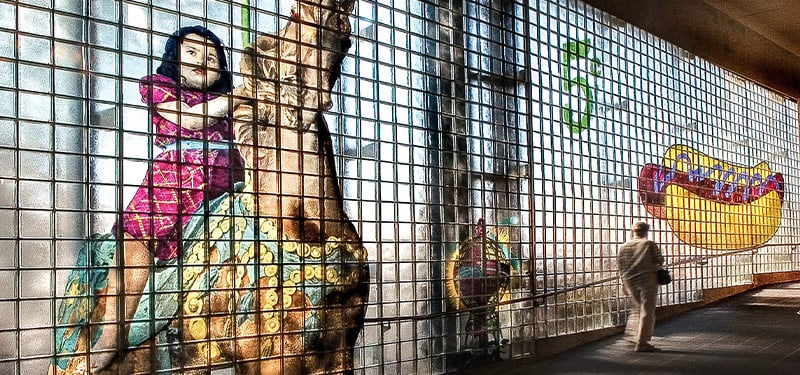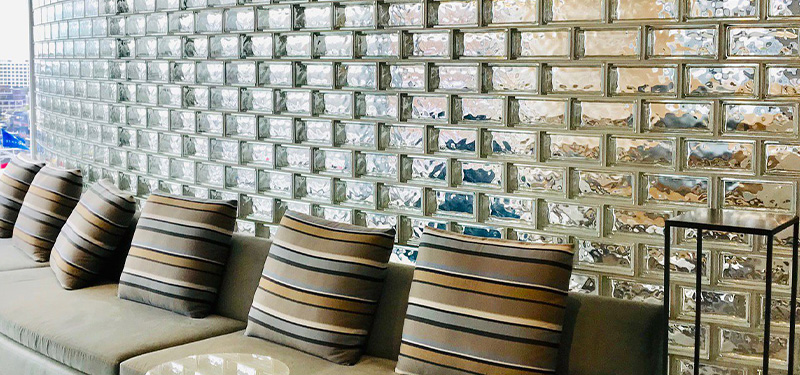A History of Glass Block Architecture
Glass blocks became widely popular in the early to mid-20th century, valued for their distinct mix of functionality and aesthetic appeal. These durable, light-transmitting building units are used for windows, walls, and walkable surfaces. The history of glass block shows its evolution into countless applications, from biotechnology to simple decorative accents. GBA offers the largest supply of glass blocks in the US, providing architects with innovative solutions like custom glass walls and walkable glass systems to add a "wow" factor to any design.
Attributes like transparency, insulating properties, and durability make glass an ideal building material. Architects and designers look to GBA as the expert in creating that "wow" design feature with glass brick walls or glass block walls. Accent walls made with glass block are more intriguing than traditional accent walls because of their transparency and light penetration. Glass block can even be customized to match any color that a designer or property owner imagines, bringing a vision to life with a colored interlayer. In addition, glass block and glass brick walls can be customized to be as transparent or translucent as you would like, so incredible amounts of light can shine through the glass block wall in ways traditional accent walls can't provide.
Glass block is emerging as a popular component of building design for both interior and exterior use. Architects throughout the world are applying glass block to their masterpieces, often earning rewards for beauty, functionality, and energy efficiency. Not only can glass block be used for interior/exterior applications, but we also offer a line of luxury glass brick that replicates the look of tradition glass brick while the light penetrates through the wall system. Glass block has a variety of sizes to choose from which can be integrated together to create incredible accent walls made of glass block.
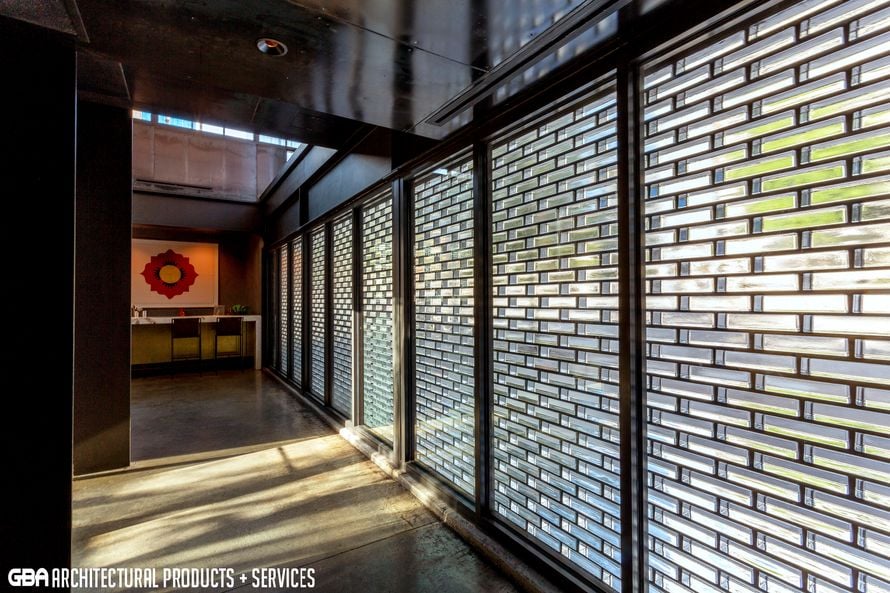 The design for The Comedor Restaurant in Austin, Texas utilized glass bricks that filter sunshine during the day and bring elevated privacy at night without ever losing light transmittance.
The design for The Comedor Restaurant in Austin, Texas utilized glass bricks that filter sunshine during the day and bring elevated privacy at night without ever losing light transmittance.
Why is Glass Block Important in Architecture and Design?
Glass block's light transmission allows light to pass through floors and walls to illuminate adjacent rooms and hallways. Glass can provide privacy with varying levels of light-permitting translucence, while still admitting generous amounts of light through. With so many glass block sizes available, design possibilities are endless, and designers are constantly finding new ways to use glass brick and block inside buildings. Breaking the glass block walls into framed sections is another way to create vivid accents in any office, storefront, or home. Framing can be customized by changing the color; for example, painting the frames black can resemble Shoji screens to give a unique look to a project.
When used as a primary exterior cladding of a building, glass block maximizes natural light, potentially illuminating the entire inside with sunlight. Glass block and glass bricks have incredible strength and take complete advantage of the light coming from the sun. Glass brick exterior walls can be incorporated into a building's exterior structure or can even be made into exterior partition walls. With the light passing through each brick, you can create endless decorative glass block walls.
In addition, glass block is a highly sustainable construction material that is recyclable and can be produced from recycled materials. Because of this feature, glass block reduces energy use for lighting and is an excellent insulator that reduces heating costs. Given the sustainable, energy-reducing nature of the material, glass blocks are often employed in the construction of many LEED-certified structures in the United States.
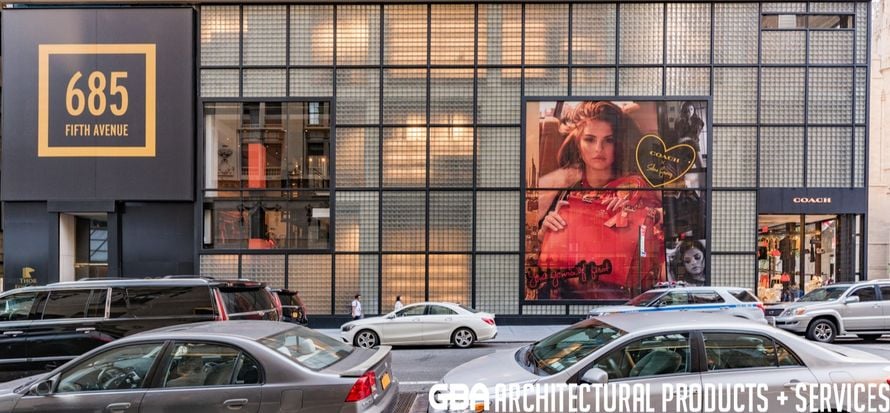
Early Uses of Glass for Construction
The history of glass block in its original form included windows that brought beauty and light to otherwise dark environments. The material gained prominence in the 1800s as a functional, light admitting material for skylights and walls segments.
In the early history of glass block, “deck prisms” were added to oceangoing ships. Before electricity, natural light could be admitted into the areas below deck, thus reducing the fire risks of candles and oil lamps.
Glass block was also used as a sidewalk-embedded, curved-glass “lens” that pedestrians could see as they walked beside busy city streets. These “vault lights” or “sidewalk lights” were not actually lights, but glass prisms that admitted and diffused light throughout a room beneath the sidewalk. The rooms were often storage areas for the building above and, without the presence of windows, benefited from the natural lighting through the glass prisms.
Sidewalk vault lights are still in use in some cities today, although many have become collectors’ items. New York City architect William Lescaze utilized the idea of vault lights to add a solid glass brick skylight. Glass block skylights are a common application to bring more natural light down through tall buildings while backlighting a rooftop deck at night.
.jpg?width=550&name=will6%20(1).jpg)
Lescaze House, NYC. Photo from (wowhaus.co.uk)
Original Patent for Glass Block
As a true construction material, however, the strength and durability of glass “bricks” for broader use was still limited
In 1907, Deutsche Luxfer-Prismen-Gesellschaft (loose translation: German Light Prism Company) patented a process to strengthen the material into glass block by fusing two sections of glass into a single unit. When the two glass pieces were joined, a hollow center was created. The partial vacuum within enhanced the insulating qualities of glass block to allow for:
- Sound deadening
- Energy insulation
- Fireproofing
In its earlier uses, glass block was utilized in much the same way as concrete blocks. And, compared to other materials, glass block was easy to install and maintain. American architects like Andrew Rebori and William Lescaze created incredible residential homes featuring glass block that remain iconic to this day.
Glass Block Walls Ceilings and Floors Add Beauty and Enhance Space
The prism effect created by the glass block facilitated the dispersion of light throughout an interior. Factories, train stations, indoor shopping areas, and arcades installed glass ceilings to provide increased natural light for visitors.
Underground railways throughout the world began using glass block ceilings to illuminate their stations. These elements are still prevalent in parts of the London Underground and Paris Metro systems.
The history of glass block continued through the Depression of the 1930s, as glass block became popular for external and internal use because of its modern style and low cost.
Today, glass block is used for interior and exterior walls to reduce energy consumption. These architectural strategies lower the cost of artificial lighting while illuminating “dead” space within a building. Glass block pavers can be placed in cast iron or concrete to create walkable glass flooring options that expose light to underground areas such as basements.
For example, a glass floor, stairway, or walkway can be aesthetically pleasing. Additionally, the glass block set in steel or aluminum mountings allows the room or space beneath to be illuminated without requiring additional artificial light sources to make the area usable.
Glass Block Architecture and Structural Glass in the 21st Century
Today, glass block is available in a broad range of colors, patterns, textures, degrees of transparency, and sizes. With modern technology, glass block may be customized to meet the needs of any project. Structural and non-structural accent walls can be created in any shape or size. GBA creates stunning glass brick and glass block accents walls with mortar, silicone, or a mortarless grid system that seamlessly fits into any wall. Further, the mortars and silicones that seal the fusion of the glass blocks have been continually improved to create a permanent storm and fire-resistant barrier.
Structural glass has become popular among designers for its distribution of natural light and ability to create open spaces. GlassWalk™ Structural Glass Floor Systems, owned by GBA, has 3 lines of beautiful structural glass: Glass Pavers, Glass Stair Treads, and Structural Glass. Over the years, GBA has fine tuned external applications of structural glass to illuminate usable space through creative and safe glass designs. Today, structural glass has become extremely popular in the use of glass walkways in homes and in concrete and glass paver applications in sidewalk or pool deck areas. Architects and Designers look to GBA for a turn-key solution to any structural glass, glass block, or glass brick project. With our expertise and knowledge, our team works with you from the start of the design until the project is fully completed.
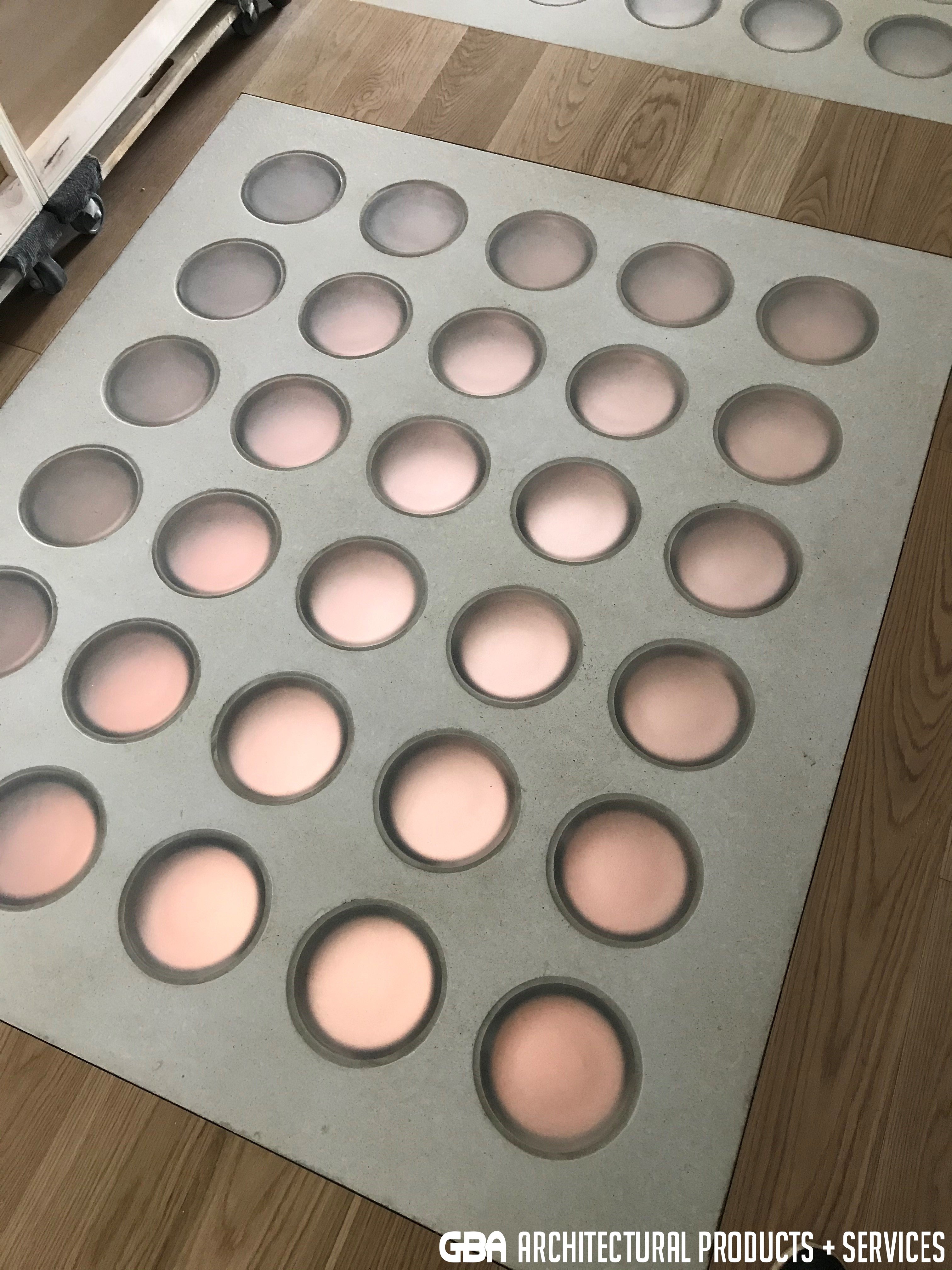
Light and Productivity
The presence of natural light is proven to enhance learning and productivity. The periodical Psychology Today summarizes a high-level study that links the availability of abundant natural light to improved sleep, vitality, and productivity. Today, more offices and classrooms are being partitioned with attractive glass block. Even office spaces use glass block walls for partitions. This provides more natural light into any office space and can boost productivity throughout the workplace. Make your glass block wall stand out even more with the use of color or by changing the transparency of the glass.
Glass Block Architecture and Security
Vandals often use basement windows to gain entry into homes and businesses, as standard pane windows are easy enough to break. When home and business owners install secure and unbreakable glass block, the would-be intruders become quickly discouraged and move on. GBA offers a full line of engineered glass block that has vandal and graffiti resistance.
Glass block has even been installed in high-security installations. For example, GBA Architectural Products + Services was chosen to incorporate glass block construction in the Howard Young Correctional Institute in Wilmington, Delaware. The premise was simply to provide the necessary degrees of security while admitting abundant natural light. The system consists of 1,000 pieces of solid glass brick cast in place with rebar reinforcement.
Besides being tamper-proof or vandal resistant, modern glass block is also blast, hurricane, and tornado resistant. High-performance engineered glass block is easy to install and is tested to meet the applicable impact codes.
-1.jpg?width=2048&name=Gadsden%20Elementary%20School%20(1)-1.jpg)
Contact GBA Architectural Products + Services
As the material of choice for many iconic structures, glass block is practical and easy to maintain. This material has been embraced by world-class architects and designers as the building feature of the future. Witness the beauty and functionality of such important structures as Maison Hermes in Tokyo, the Library at the University of Deusto in Spain, and the 11-story Iulm University digital library in Milan, Italy.
Projects by GBA Architectural Products + Services include parts of the Puck Building and Stillwell Avenue MTA Station in New York, St. Ann’s Warehouse in Brooklyn, and the 21C Museum Hotel in Oklahoma City.
There is no denying the beauty and practicality of glass block. Since the early days when prism deck glass illuminated the dark below decks of sailing ships, glass block development has come a long way. The idea of illuminating dark below decks is still achievable today with GBA's concrete and glass paver walkable glass applications.
Consider glass block, glass brick, or any structural glass walking surface for your next project. Glass block is beautiful, sustainable, durable, and secure. Structural glass has been designed with anti-slip textures to keep your glass floor safe.
Contact USA’s experts in glass block construction and technology. For information, phone the GBA Architectural Products + Services experts at any of the numbers listed below:
- Midwest: (877)-280-7700
- East Coast: (212)-255-5787
- West Coast: (213)-634-7050

